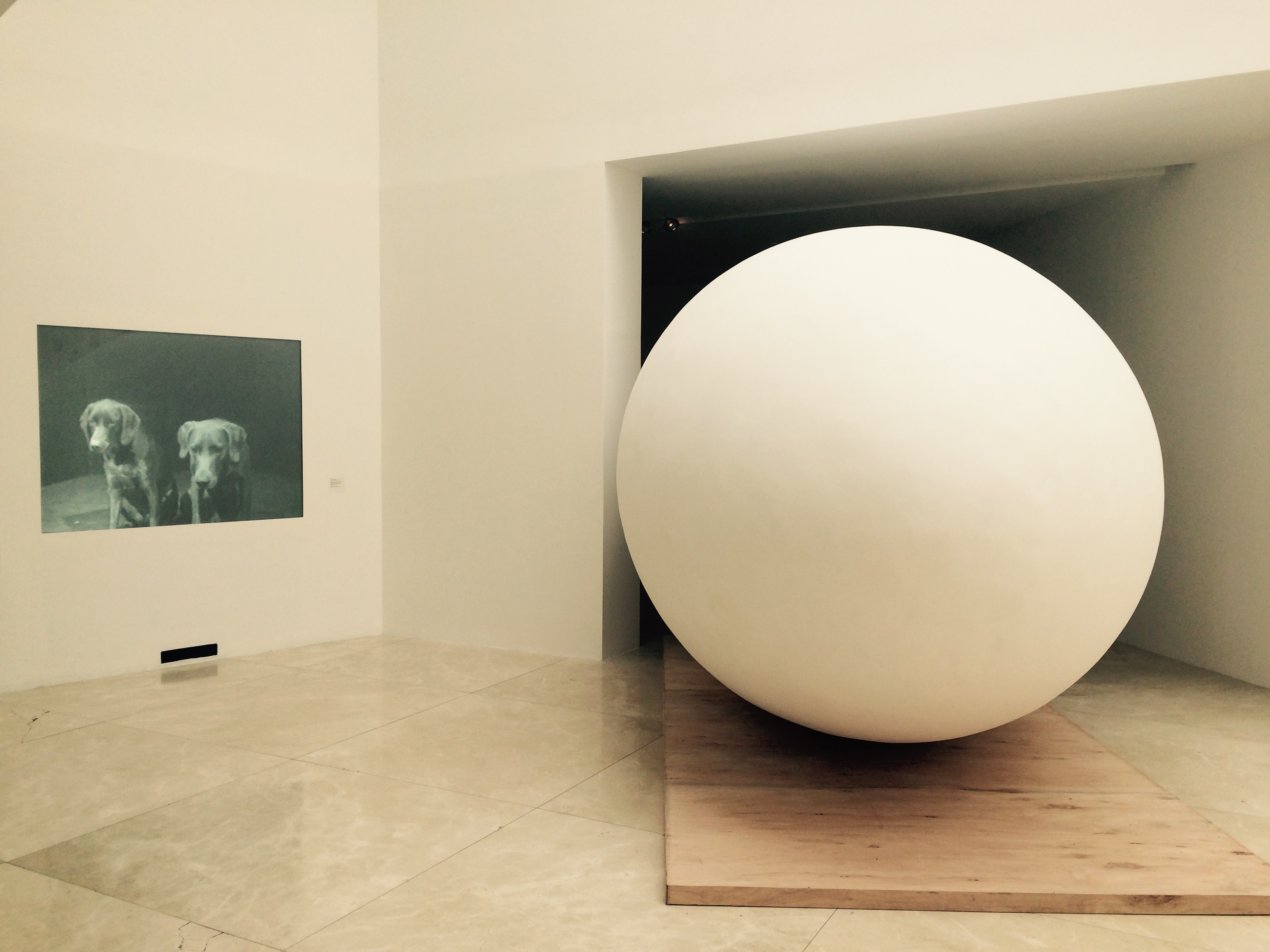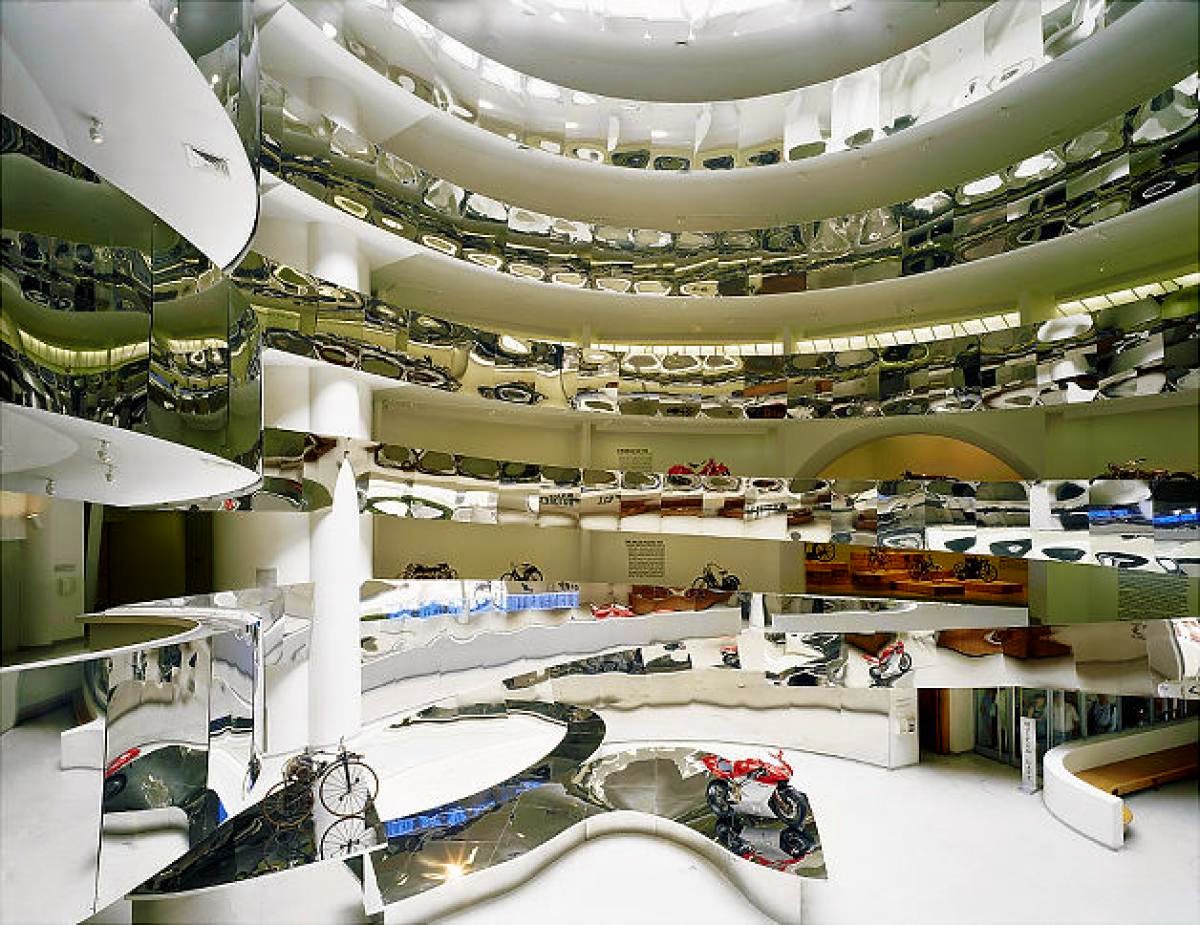An Essay by Kerr Houston
There it sits: at once immense and pristine, its form characterized by a basic perfection even as it forms an uncanny presence in the lower lobby of Buenos Aires’ handsome Museo de Arte Latinamericano (MALBA). What, we wonder, is this oversized egg doing here?
A nearby wall text offers a partial answer: the egg, we read, is a re-creation of a 1965 sculpture by the Argentinian artist Federico Manuel Peralta Ramos. Entitled Nosotros afuera (We, the outsiders), that work was destroyed shortly after is creation by the artist (who subsequently died in 1992). Now it has been temporarily resurrected, along with a bizarre curatorial statement that argues, whimsically and airily, that Peralta Ramos’ work should be seen as an early anticipation of the internet (it’s a container of information; it features no straight lines). Maybe, maybe not – but still, what exactly does this egg want from us? What can it offer us? And why should we care about it?
Such questions, of course, are rather stock ones: they’re among the thoughts that inevitably come to mind as we take in virtually any piece of art. But might the way in which we answer them reveal something about the state of contemporary art? In a contentious piece in a recent issue of Commentary, Michael Lewis (a professor of art and architectural history at Williams College) argued that in recent decades the general public has answered such questions with a collective yawn, or shrug. Since the 1970s, he contends, contemporary art has lost sight of its public. Characterized by a willful anarchy and a lack of faith in any traditional notion of civilization, contemporary art has nothing of any truly broad relevance to say. Rather, it has hobbled itself, or painted itself into a rhetorical corner: it’s reduced to a series of vacuous, rebellious gestures. Chris Burden had himself shot; Andres Serrano submerged a crucifix in urine. Now MALBA builds an egg, and compares it to the internet.
In a general sense, of course, Lewis’ argument is exhaustingly familiar. We’ve seen it all before, in the writings of a long line of (seemingly always male, and always white) critics that includes Kenyon Cox, Royal Cortissoz, John Canaday, and Hilton Kramer. In the view of these critics, the Golden Age is always receding: the halcyon days of universal understanding have given way to a corrosive relativism, and traditional values and standards of propriety have yielded to alarming breaches in protocol. Abstract painting? Cubism? Body art? They are, from such a viewpoint, symptoms of a moral decline, or a tragic surrender. And they inevitably result – so the argument goes – in a deadly disengagement. Or, as Lewis puts it, “the American public – left with an impressionistic vision in which urine, bullwhips, and a naked but chocolate-streaked Karen Finley figured largely – drew the fatal conclusion that contemporary art had nothing to offer them.”
Of course, that’s a rather remarkable claim, given that attendance figures at American art museums have never been higher. But Lewis has an answer here: art museums no longer show what he considers art. Instead, they give themselves over to mere spectacle, playing to the crowd while abdicating their venerable role as custodians of culture. Thus, the Guggenheim puts together a show of motorcycles, and the Met rolls out the dresses of Alexander McQueen. The hundreds of thousands of visitors who pay to see such shows may think that they’re enjoying themselves while looking at some interesting art – but, Lewis holds, they’re wrong. Rather, they’re victims of a seismic collapse, in which the art world has abandoned any interest in common cultural goals or in the venerable notion of quality, and devoted itself to celebrity, sensation, and even (gasp) to the study of fashion and industrial design.
If this all feels very long ago and far away – well, in one sense, it is. After all, a number of alarmed critics issued similar obituaries in response to the 1913 Armory Show, in which the work of a number of important European modernists challenged conventional notions of taste. Editorial cartoonists mocked the show, President Roosevelt refused to accept some of the paintings as art, Matisse was hanged in effigy in Chicago, and Cortissoz wryly declared that he did not like to chew sawdust. And yet, then as now, the crowds kept coming. Despite the handwringing of conservative critics and their strident assurances that the works in the show would only debase any national conversation about the arts, the show was by most accounts a huge success. Many of the featured works sold, attendance figures easily surpassed the expectations of organizers, and the show has taken its place as a formative moment in the history of modern art.
But one man’s heaven, it seems, is another man’s hell. For Lewis, the popularity of museum shows is a perverse debacle, proof that the Met now plays to the lowest common denominator, instead of pursuing a more rarified art. Sure, crowds flocking to see motorcycles at the Guggenheim may seem like a rather benign phenomenon (for, after all, in Renaissance Florence they flocked to see Savonarola burned at the stake). To a conservative commentator, however, it’s only part of a much more worrisome collapse of traditional voices of authority. We live in a world, after all, where a pope can ask, rhetorically, “Who am I to judge?” and the American president can urge Christians to get off their high horse. In such a world, absolutes are clearly an endangered species. And yet absolutes, for a thinker such as Lewis, are absolutely essential to the creation of meaningful art. Indeed, Lewis contends, the creation of what he calls serious and lasting art requires “some sort of larger system of belief, a larger structure of continuity that permits works of art to speak across time.”
But what does that mean, precisely? For Lewis, Susan Sontag’s 1964 essay “Notes on Camp” offers a convenient symbol. Her interest in irony and in arch rhetorical distance (“Camp sees everything,” proclaimed Sontag, “in quotation marks”) distills a tendency towards pure relativism that soon became, in Lewis’ opinion, endemic. Perhaps – although I actually think that a more relevant example of an emerging aesthetic relativism can be found in Leo Steinberg’s 1962 essay “Contemporary Art and the Plight of the Public.” There, a young art critic ruminated on a series of paintings by a young Jasper Johns and wondered what it means to speak of artistic meaning. “Does it mean anything?” he asked. “To whom? To the schoolboy learning to read? To posterity?” Such questions rapidly begin to erode, in their emphasis upon the individual perspective, our sense of any larger system of belief.
Unless, that is, we realize that art has always meant different things to different people. Universal meaning didn’t simply collapse in 1964, or in 1962; arguably, it has always been more of a dream than a fact. Think, for instance, of the commentaries of the 15th-century sculptor Lorenzo Ghiberti, who gently mocked those citizens of Siena who felt that a recently discovered statue bearing the name of the classical sculptor Lysippos could alter the outcomes of military conflicts. To the Sienese, the ancient masterpiece was magical and efficacious; to Ghiberti, by contrast, it was an aesthetic object, to be admired for its artistic virtues.
Or think of Michelangelo’s celebrated David, now widely seen as an icon of the Italian Renaissance but clearly subject, during the Renaissance, to a variety of readings. Initially designed to stand well above ground level, but eventually moved (after a vigorous debate) to a position before the Palazzo Vecchio, the sculpture was interpreted variously by various onlookers. Patriots saw David as an embodiment of Florentine courage; opponents of the Medici read the abbreviated stump as a reference to the possibility of renewal; artists saw the scale of the sculpture as part of an attempt to rival Donatello. And Michelangelo? The work’s author seems to have read the piece as a reflection of his own trials and exertions; on a sheet of paper now at the Louvre, he wrote, David with his sling and I with my bow.
Clearly, then, “serious and lasting” art doesn’t have to mean the same thing to everyone. Indeed, you could argue that some art lasts precisely because it can mean different things to different people. Still, though, that needn’t imply a pure, anarchic relativism. Rather, you might call it a refreshing departure from a narrow aesthetic tradition that was long defined by a remarkably homogenous group of writers and institutions. The most salient message of some of the most affecting works of contemporary art, at the end of the day, is not that anything goes – but that a number of perspectives have traditionally been marginalized by the art world.
That was part of the point, for instance, of Fred Wilson’s 1992-3 Mining the Museum exhibition, in which the artist acted as curator, creatively displaying a range of objects in the collection of the rather staid Maryland Historical Society. Some of the objects were utterly familiar, but Wilson paired them with works in the museum’s collection that had never been shown, because of their association with violence perpetrated on the state’s African-American and Native American populations. A whipping post thus took its place next to an antique chair, and slave shackles were exhibited next to examples of colonial silversmithing. In the process, the museum’s traditional narrative gave way to an acknowledgment of a more complex past. Oh, and by the way: attendance at the MHS soared, and Wilson’s exhibition was extended several times, even as textbooks began to include it as a seminal work of institutional critique. It was, you might say, both serious and lasting.
To claim, then, that contemporary art no longer shapes or defines our collective values is effectively to argue that our collective values cannot embrace diversity, or complexity. To propose, as Lewis does, that contemporary art no longer shapes our image of ourselves in meaningful ways is to imply that silver made for 18th-century aristocrats affects us meaningfully, while a roughly fashioned stock simply cannot. In short, it’s an impoverished argument. Sure, contemporary art involves challenges to traditional ideals (like an attention, say, to the intricacies of engraving). But it issues such challenges precisely in order to show that those ideals came with a considerable cost: those handsomely wrought tea services, after all, were borne by black servants who were bought and sold.
And yet contemporary art is not merely didactic or polemical; it can also be wrenching, or viscerally affecting. Think, for instance, of Maya Lin’s Vietnam Veterans Memorial, which has occupied a prominent position on the Washington Mall since 1982. To some veterans’ groups, the piece was an insult: it was too abstract, too open-ended, too unprecedented. War monuments, ran the argument, included heroic figures – and where were the figures here? Wonderfully, though, Lin’s installation rapidly became one of the most popular and most powerful war monuments in the world. In the end, in an effort to appease the veterans, a conventional figural group was in fact appended – but that group is largely overlooked by most visitors. It’s the wall, rather, that they line up to see: millions of them, in a vast, implicit rejection of Lewis’ claim that the American public has reached the fatal conclusion that contemporary art had nothing to offer, or has nothing important to say about who we are.
But is Lin’s piece too dated to be of relevance here? Has the world of contemporary art somehow lost its ability to create meaningful connections in the years since 1982? For Lewis, that seems to be the case: in his view, the past few decades read as an especially barren period. But for, say, the thousands of visitors who lined up for hours in order to sit across a table from Marina Abramowić (in a 2012 MoMA exhibition entitled “The Artist is Present”), such a characterization would presumably seem ridiculous. Indeed, many of those viewers were so moved by the experience that they broke down in tears.
Some of their responses, in turn, were collected on a touching Tumblr page that also functions as a concise rebuttal of Lewis’ dry claim that a collapse in the consequence of art “is the central cultural phenomenon of our day.” Sure, we could try to tell such viewers that their experience actually means very little – but they probably won’t even hear us, as they’re so involved in their own experience.
Ultimately, then, Lewis seems to be a temperamental cousin of the perpetually worried Earthworm in Roald Dahl’s James and the Giant Peach: he’s an inveterate complainer, intent on finding the dark side in a silver cloud. And yet, as even the Earthworm eventually realizes, “The problem is… well, the problem is that there is no problem!” Yes, contemporary art eschews familiar formulas, and, yes, it is wary of prescribing specific courses of action. It doesn’t tell us, in simple terms, what to do.
Rather, it tends to place us in open situations in which we are prompted to think about who we have been, or might want to be. It establishes a horizon of possibilities, you could say, without dictating an end result. Admittedly, such a challenge is unsettling: indeed, it’s possible to feel sympathy for shaken commentators like Lewis, who yearn for the confident paternalism of a Le Corbusier. But it can also be exhilarating, precisely because we can now participate in the construction of meaning. In engaging with such work, arguably, we forge new and stronger values.
As we peer at Peralta Ramos’ egg, then, we begin to appreciate more fully the appropriateness of its title: Nosotros afuera. Of course we are outsiders, for we can access only the egg’s brittle exterior: its magical, generative contents are concealed inside.
We’re outsiders in a second sense, as well, if we attend to the work’s sheer strangeness: its surreal scale and blunt arbitrariness challenge our conventional assumptions. And yet at the same time in looking at such a work we also come to feel like insiders, for it is ultimately we who grant the egg its significance, who invest it with meaning, who wrap it in interpretations. The egg sits in front of us, a mute object, cast into the world. But it occurs inside of us, as we look, and ponder, and project. We form part of a temporary crowd around a work reconstituted a half century after it was first shown. And we become, in the process, something new and meaningful, something that confirms all over again the intense relevance of contemporary art – something that you might even call, indeed, nosotros adentro.
Author Kerr Houston teaches art history and art criticism at MICA; he is also the author of An Introduction to Art Criticism (Pearson, 2013) and recent essays on Wafaa Bilal, Emily Jacir, and Candice Breitz.












